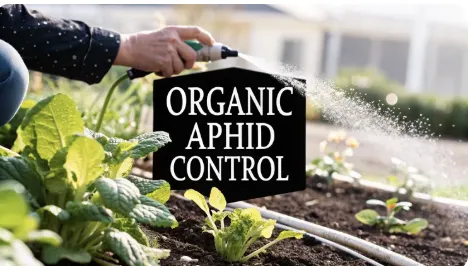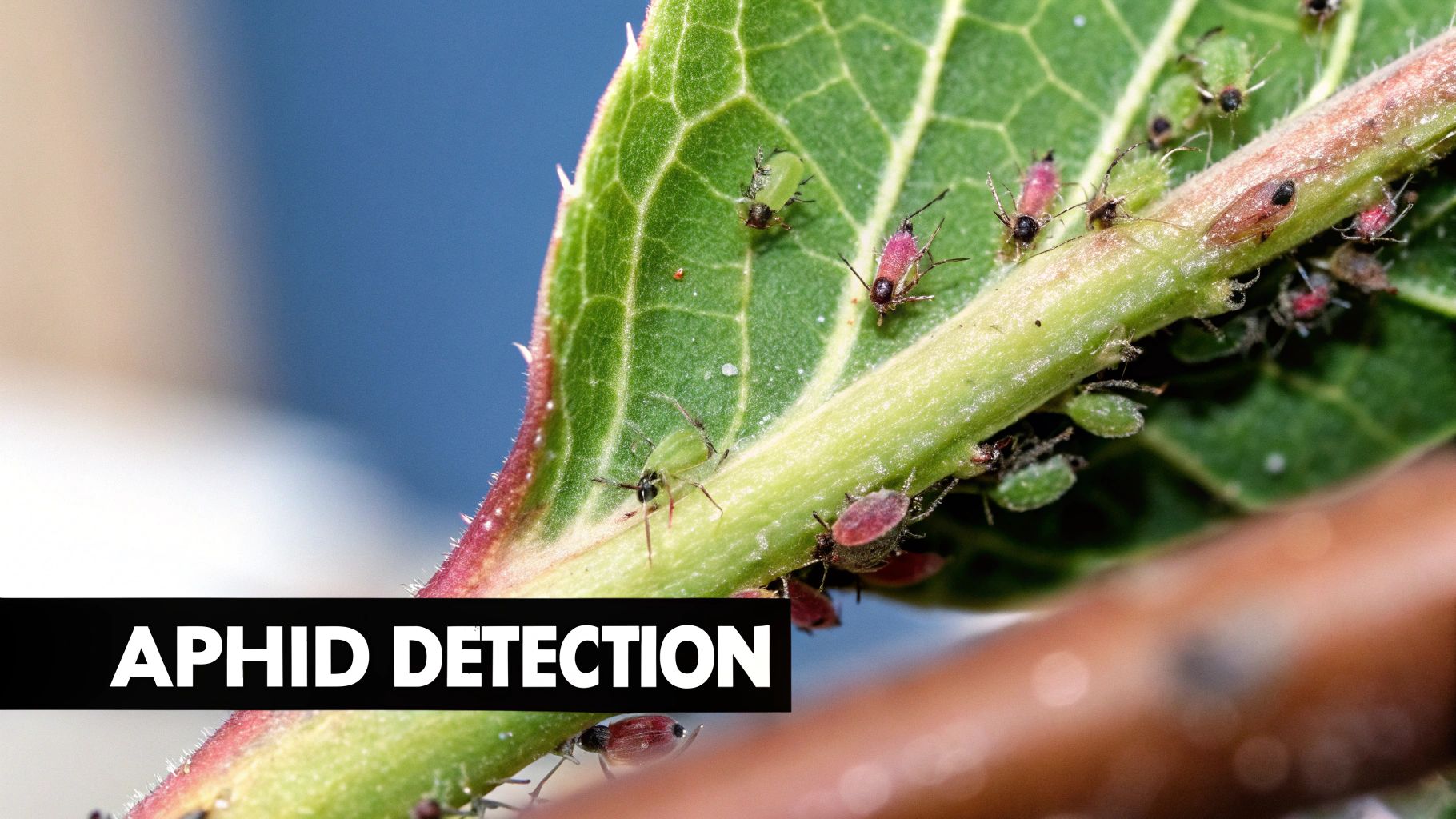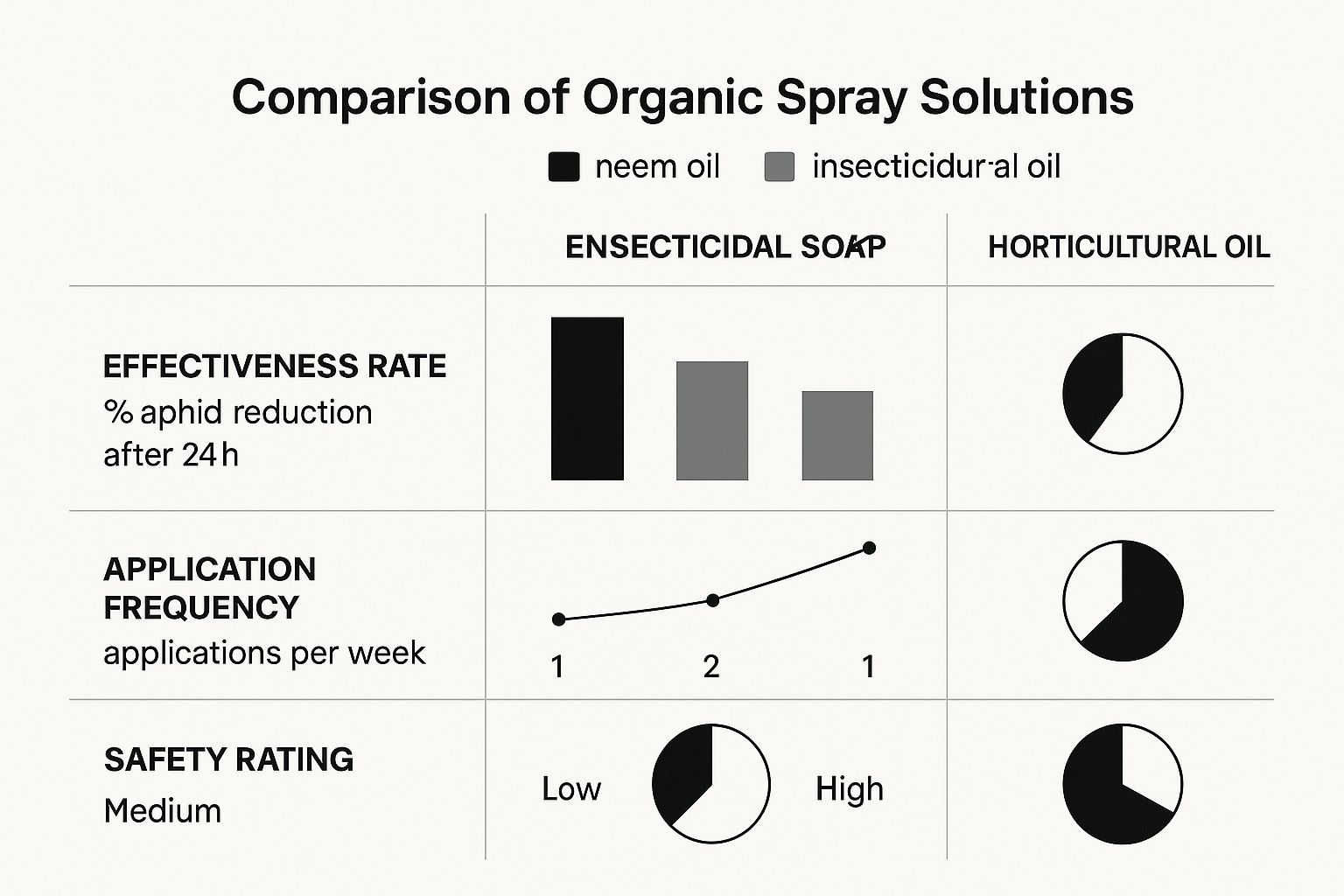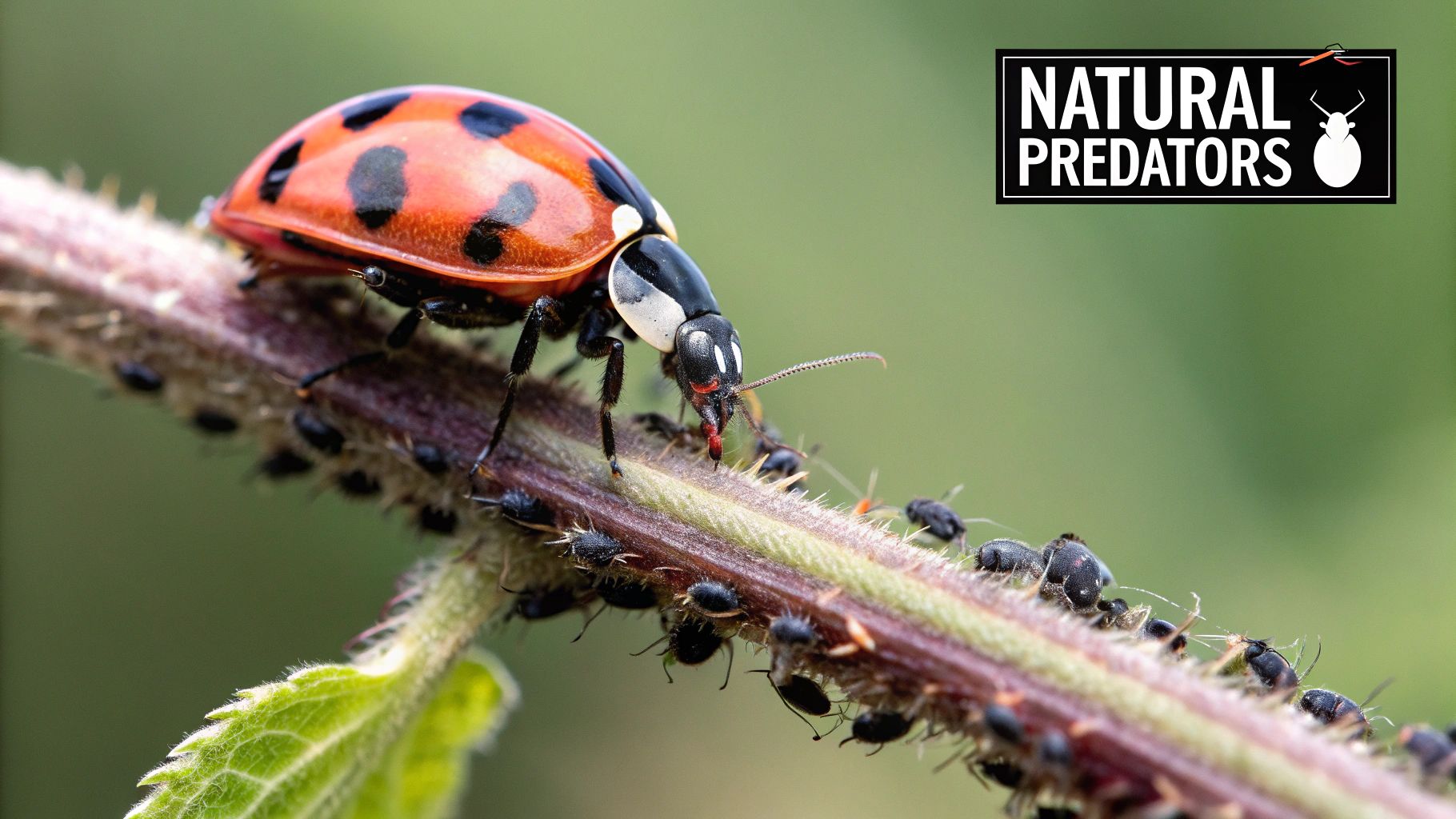
Aphid Control Organic: Natural Tips for Healthy Gardens
Aphid Control Organic: Natural Tips for Healthy Gardens
The first sign of aphids is your cue to act. You'll usually find these tiny, pear-shaped bugs clustered on new growth or hiding on the undersides of leaves. Spotting them—or the sticky mess they leave behind—is the most critical step in getting ahead of a problem before it gets out of hand.
Identifying and Understanding an Aphid Invasion
Before you can solve a pest problem, you have to play detective. Aphids might be small, but their impact is anything but. Catching an infestation early is crucial because their populations can explode almost overnight. A single female aphid can give birth to dozens of live young without ever mating, leading to exponential growth that can quickly overwhelm a plant.
What to Look For
Often, your first clue won't be the bugs themselves, but the damage they leave in their wake. Keep a sharp eye out for these classic signs:
Curled or Twisted Leaves: Aphids use their tiny, piercing mouthparts to suck the sap right out of tender plant tissue. This feeding frenzy often causes new leaves on plants like roses or tomatoes to curl up, twist, or turn yellow.
Sticky "Honeydew": As aphids feed, they excrete a sugary liquid called honeydew. It makes leaves feel sticky to the touch and attracts other pests, especially ants. You'll often see ants "farming" the aphids, protecting them from predators in exchange for this sweet reward.
Sooty Mold: That sticky honeydew can also lead to the growth of a black, powdery fungus called sooty mold. While it doesn't directly harm the plant, it coats the leaves and blocks sunlight, which interferes with photosynthesis.
Stunted Growth: A heavy infestation drains a plant of its vital nutrients. This leads to poor growth, weak stems, and deformed flowers or fruit. This is a huge problem for young, vulnerable seedlings.
Why a Small Problem Escalates Quickly
The real danger with aphids isn't just the direct damage from their feeding. They are notorious for spreading plant viruses. As they move from an infected plant to a healthy one, they can transmit diseases that are often untreatable, potentially devastating an entire crop.
This isn't just a small-scale garden issue; it has serious agricultural implications. For example, aphids on a broccoli crop can slash yields by up to 50% if they aren't controlled.
By recognizing these early warnings, you shift from a reactive to a proactive gardener. Understanding how to spot aphids is the foundation for all the organic control methods that follow, allowing you to intervene before your plants suffer significant harm.
Learning to identify pests on specific plants is an invaluable skill. For instance, aphids are one of several common lettuce pests, and recognizing them is key to protecting your harvest. You can check out our guide on troubleshooting issues with leafy greens for more specific tips.
Building Your Garden's Natural Defenses

The best way to handle an aphid problem is to make sure you never have one in the first place. This isn't about luck; it's about building a garden ecosystem that’s naturally resilient and just plain uninviting to pests.
It all starts from the ground up. Strong plants are your first and best line of defense, and strong plants grow in rich, living soil. Aphids and other pests are opportunists—they’re drawn to plants that are struggling from a lack of nutrients or inconsistent watering. A stressed plant basically sends up a flare, signaling it's an easy meal.
By focusing on soil health through practices like learning how to compost at home, you’re turning kitchen scraps into the black gold that gives your plants the resources to fight back on their own.
Using Plants as Pest Repellents
One of the smartest moves you can make is putting your plants to work for you through companion planting. This is more than just making the garden look pretty; it's a strategic way to create a diverse environment that confuses pests and welcomes their predators.
Aphids find their favorite vegetables by scent. You can throw them off the trail by interplanting your crops with aromatic herbs and flowers that mask the smell of their next meal. A few of my go-to defenders include:
Chives and Garlic: Their strong, sulfurous scent is a huge turn-off for aphids. I always tuck them in around my lettuce and kale beds.
Mint and Catnip: These are incredibly effective repellents, but they are aggressive growers. Be sure to plant them in containers unless you want them to take over.
Marigolds: A classic for a reason. Certain varieties release a chemical that repels pests both above and below the soil, making them a fantastic garden protector.
A garden filled with a mix of plants is a tough landscape for pests to navigate. This diversity is the heart of organic aphid control. It makes it much harder for an infestation to explode compared to a monoculture where pests can hop from one identical plant to the next with ease.
This approach of using specific plants to protect others is a fundamental tactic in good garden design. To really get into the weeds with this, exploring a solid vegetable companion planting guide can give you detailed charts and pairings to maximize your garden’s natural defenses. (https://thegroundedhomestead.com/post/vegetable-companion-planting)
Simple Tactics for a Stronger Garden
Beyond your plant choices, a few simple habits can make a world of difference.
Watering consistently is a big one. Drought-stressed plants are aphid magnets, so aim for deep, less frequent soakings that encourage strong, deep roots. Shallow, daily sprinkling just creates weak plants.
Another clever trick is using reflective mulches. You can buy silver-colored plastic mulch, but even strips of aluminum foil laid on the soil around vulnerable plants like peppers or squash can work wonders. The reflected sunlight disorients incoming aphids and makes it nearly impossible for them to land.
This simple physical barrier can dramatically cut down the number of pests that ever find your garden, setting you up for a much less stressful growing season.
Bring in Nature’s Clean-Up Crew
Trying to fight an aphid infestation all by yourself is a losing game. A much smarter, more sustainable strategy is to recruit the tiny predators that are already perfectly designed for the job. By creating a welcoming habitat, you can attract beneficial insects that will happily work around the clock, turning your garden into a self-regulating ecosystem that keeps pests like aphids in check.
Think of it as setting up a neighborhood watch for your plants. The most valuable members of this team are the voracious aphid hunters. Ladybugs are the most famous, and for good reason—a single larva can devour 40 aphids per hour. But don't overlook lacewings, often called "aphid lions" in their larval stage, or the tiny hoverflies whose larvae feast on hundreds of aphids before they mature.
These insects aren't just visitors; they're your garden's best friends.
How to Attract Your Garden Allies
So, how do you send out the invitation? It's simpler than you think. Beneficial insects are drawn to gardens that provide three key things: food, water, and shelter. The easiest way to do this is by planting a diverse mix of flowers and herbs that offer the nectar and pollen adult predators need to thrive and lay their eggs.
A few powerhouse plants to get you started include:
Dill and Cilantro: These herbs produce clusters of tiny flowers that are perfect landing pads for hoverflies and parasitic wasps.
Sweet Alyssum: This low-growing flower acts as a "living mulch," offering both shelter and a consistent nectar source.
Yarrow and Cosmos: Their flat-topped blooms are like a buffet table for ladybugs and lacewings.
Simply tucking these into your vegetable beds creates a powerful support system. You can explore more ideas for building a balanced garden in our broader guide on natural pest control strategies.
The goal isn't a pest-free garden—that’s an impossible, unnatural standard. The real aim is to create a balanced environment where predator populations are strong enough to prevent any single pest, like aphids, from getting out of hand and taking over.
Biological controls, like introducing these predatory insects, are incredibly effective. In fact, studies show they can reduce aphid populations by 60–85%, making this a cornerstone of low-impact, sustainable gardening. You can get a closer look at the science backing these organic strategies.

Before you buy beneficial insects, it helps to know who does what. Here's a quick rundown of the top performers you can attract or introduce to your garden.
Top Beneficial Insects for Organic Aphid Control

Attracting a diverse team of these predators is far more effective than relying on just one. Each insect has slightly different habits, so a varied crew ensures your garden is protected from multiple angles.
Making Purchased Predators Feel at Home
If you decide to jump-start your predator population by purchasing ladybugs, timing and technique are everything. Releasing them in the middle of a hot, sunny day is a recipe for disaster—they'll just fly away in search of a better spot.
For the best results, wait until evening. Lightly mist your infested plants with water first. This gives the ladybugs a much-needed drink and encourages them to stay overnight. When they wake up the next morning to an aphid breakfast buffet, they are far more likely to stick around, lay eggs, and establish a colony.
This small detail can be the difference between a successful release and a wasted investment. When you learn to work with nature's cycles, you build a resilient garden that can largely defend itself.
Practical DIY Sprays for When Aphids Explode

Sometimes, no matter how much you encourage ladybugs or keep your plants healthy, an aphid population just explodes. It happens to every gardener. When you’re facing a full-blown infestation, you need to act fast, and that’s where homemade sprays become your best line of defense.
These simple, organic solutions can knock down an aphid invasion without resorting to harsh chemicals that harm the rest of your garden's ecosystem. The real key to making them work, though, is thoroughness. Aphids are notorious for hiding on the undersides of leaves and tucked deep into new growth. A quick mist over the top of the plant isn’t going to cut it. You have to get in there and coat every surface, making sure the spray makes direct contact with the pests.
The Simple Soap Spray Solution
This is the first spray I reach for and often the only one I need. It’s incredibly effective and works on a physical level, not a chemical one. The soap dissolves the waxy outer layer on an aphid's soft body, which quickly leads to dehydration and death. It's my go-to for immediate population control.
Putting it together is easy. You’ll just need:
A clean spray bottle. If you're reusing an old one, make sure it’s completely rinsed of any past chemical residue.
Pure liquid soap. Castile soap is perfect for this. Steer clear of detergents or any soaps with degreasers, moisturizers, or heavy fragrances, as those extras can scorch your plant leaves.
Water. If you have hard water, using soft or distilled water will help the soap work a little better.
Just mix one to two teaspoons of the soap into one quart of water. Give it a gentle shake to combine, and you're good to go. I always recommend testing your mix on a single leaf first—wait 24 hours to make sure the plant doesn’t show any signs of stress before you spray the whole thing.
Upgrading Your Arsenal with Neem Oil
If the soap spray isn't quite doing the job or you're dealing with a really stubborn infestation, it's time to bring out the neem oil. This stuff, extracted from the seeds of the neem tree, is a true powerhouse for organic gardeners. It works in several ways at once—acting as a repellent, an anti-feedant (stopping them from eating), and a growth disruptor that messes with the aphid life cycle.
To mix up a potent neem oil solution, you'll want to combine:
One quart of warm water
One teaspoon of pure, cold-pressed neem oil
A half-teaspoon of mild liquid soap (this is just to help the oil and water mix, a process called emulsifying)
Shake this mixture vigorously right before you use it and apply it immediately. Neem oil starts to break down once it's diluted, so you can't mix it up and save it for later. One of the best things about neem oil is that its effects linger, protecting the plant for several days after you've sprayed.
Application Pro Tip: Always, always apply these sprays in the early morning or late evening. If you spray in the heat of the day, the water droplets can act like tiny magnifying glasses on the leaves, leading to sunburn. This timing also keeps the spray away from active pollinators like bees, which is just good garden stewardship.
A Spicy Repellent for Stubborn Pests
Sometimes you need a different approach, one that focuses more on making your plants an unpleasant place to be. That's where a garlic and pepper spray comes in. This mix doesn't kill aphids on contact like soap or neem. Instead, it makes your plants taste and smell awful to them, encouraging the survivors to pack up and move on.
You can whip this up by blending two whole cloves of garlic and a teaspoon of cayenne pepper (or one whole hot pepper) with a quart of water. Let that mixture steep overnight. The next day, strain it through a cheesecloth to get rid of any solids that could clog your sprayer nozzle.
Add just a single drop of soap to help the spray stick to the leaves, and you've got a fantastic deterrent. This is a great organic aphid control method to use between other treatments to keep them from coming back.
Sustaining a Healthy, Aphid-Free Garden for the Long Haul

Beating aphids isn't about one big battle. It’s about building a garden that can defend itself.
The real secret to organic aphid control is shifting your mindset from quick fixes to long-term stewardship. You're not just fighting a pest; you're cultivating a resilient, balanced ecosystem where pests simply struggle to get a foothold. This is the final, and most important, piece of the puzzle.
Your Eyes Are Your Best Tool
The most powerful weapon you have against aphids is your own attention. I can't stress this enough. A daily or every-other-day walk through the garden does more than almost any spray. It’s your chance to connect with your plants and catch trouble before it explodes.
Look for those first subtle signs we talked about—a single curled leaf, that first tiny cluster of aphids, or a trail of ants marching up a stem. When you spot them this early, the fix is simple. Snip off the leaf or hit it with a sharp blast of water. Problem solved.
Think of it as preventative maintenance for your garden. You don’t wait for your car to break down to check the oil. Regular garden check-ins are your way of ensuring everything is running smoothly and catching minor issues before they require a major overhaul.
Think Like a Gardener, Not a Firefighter
Beyond your daily walk-through, a little forward-thinking each season will do wonders for breaking pest cycles. These aren't complicated chores; they're just smart habits that form the bedrock of a truly sustainable garden.
Here are two of the most effective strategies:
Rotate Your Crops: Aphids, especially root aphids, can hang out in the soil over winter, just waiting for their favorite meal to be planted again. If you plant tomatoes in the same spot year after year, you’re basically setting the table for them. By rotating your plant families—say, planting beans where your potatoes were last year—you disrupt their life cycle and starve them out.
Clean Up in the Fall: Don’t leave spent, dying plants in the garden to rot over winter. That old plant debris is the perfect five-star hotel for overwintering aphid eggs. A thorough end-of-season cleanup is one of the best things you can do to lower the pest population you'll face next spring.
This shift toward sustainable, organic methods isn't just happening in backyards. The global aphid control market, valued at around $2.5 billion, is seeing huge growth as more people demand biological and organic solutions. You can read more about these market trends favoring sustainable pest management if you're curious.
It All Comes Together with Integrated Pest Management
Success, in the end, comes from weaving all these organic strategies into a single, holistic system. In the gardening world, we call this Integrated Pest Management (IPM), but don't let the fancy name intimidate you.
IPM isn't a product you buy; it's a philosophy. It means using everything in your toolbox—cultural controls like crop rotation, biological controls like beneficial insects, and manual controls like sprays and pruning—in a smart, synergistic way.
When you focus on building healthy soil, encouraging your garden's natural predators, and staying vigilant, you create a multi-layered defense. Your garden becomes a robust ecosystem where nature itself does most of the pest control for you. That, right there, is the true goal of organic gardening.
Common Questions About Organic Aphid Control
Even when you've got a solid plan, questions pop up. Going organic with pest control can feel like learning a new language, but a few straight answers are usually all you need to feel confident in the garden again. Let's dig into some of the most common ones I hear.
One of the biggest worries is whether organic sprays will hurt the very insects we’re trying to attract. It’s a fair question. While they're miles safer than synthetic pesticides, things like insecticidal soap and neem oil can still harm beneficials like bees or ladybug larvae if you hit them directly.
How Often Should I Be Spraying?
If you're dealing with a full-blown infestation, plan on applying your chosen organic spray every 5 to 7 days. You have to be consistent. These treatments don't hang around for long and they won't kill aphid eggs, so this schedule lets you catch the newly hatched aphids before they have a chance to reproduce.
Keep this routine up until you see the aphid numbers drop off significantly. Make sure you're coating everything—especially the undersides of leaves where aphids love to camp out. And always spray in the cool of the early morning or late evening. This prevents leaf scorch and keeps pollinators safe.
Once things are back under control, you don't have to stop completely. A preventative spritz every two to four weeks during the peak season can stop new colonies from getting a foothold.
Are These Organic Methods Safe for My Pollinators?
Absolutely, protecting your garden's allies should be at the top of your list. This is where timing becomes everything. The golden rule is to never spray when pollinators are active. By treating your plants at dusk, you give the spray plenty of time to dry before the bees and other helpers show up the next morning.
Another key is to be precise. Instead of fogging the whole garden, focus your spray directly onto the aphid clusters. This targeted approach dramatically cuts down on accidental exposure for other insects.
Your best long-term strategy is to build an ecosystem that polices itself. Rely on prevention, companion planting, and natural predators as your primary defense, using sprays only as a targeted tool for significant outbreaks. This approach protects the delicate balance of your garden.
Will These Tactics Work in a Small Container Garden?
You bet. Organic methods are perfect for container gardens, where a small pest problem can explode almost overnight. Companion planting is especially powerful in these tight quarters.
Potted Herbs: Tuck some chives or basil into the same container as your tomatoes or peppers. Aphids hate the smell.
Trap Crops: Plant a nasturtium in a pot right next to your vegetables. It'll act as a decoy, luring aphids away from your main crops. Once it's covered, you can just remove the infested leaves or toss the whole plant.
Manual Removal: In a small setup, a quick, sharp blast of water or even just wiping the aphids off with your fingers is often enough to keep them in check.
Container gardens really thrive with these gentle, proactive methods. You'll end up with a healthy little ecosystem right there on your patio or balcony.
At The Grounded Homestead, we believe in empowering you with the knowledge to grow healthy, organic food. For more tips, guides, and inspiration for your gardening journey, visit us online.


Facebook
Instagram
X
Youtube